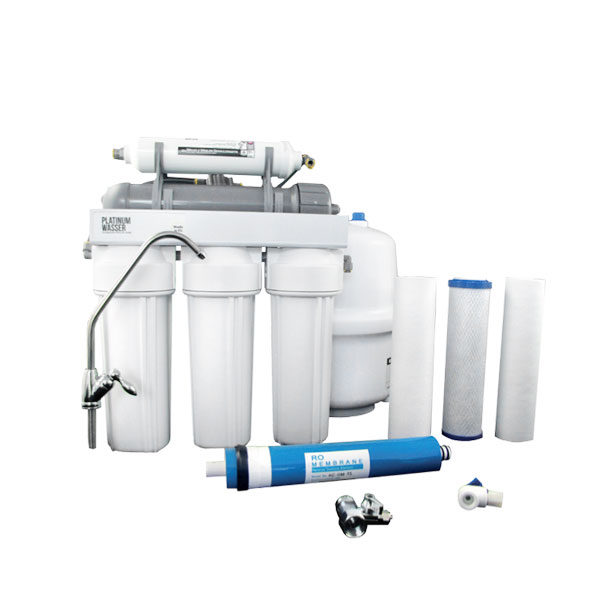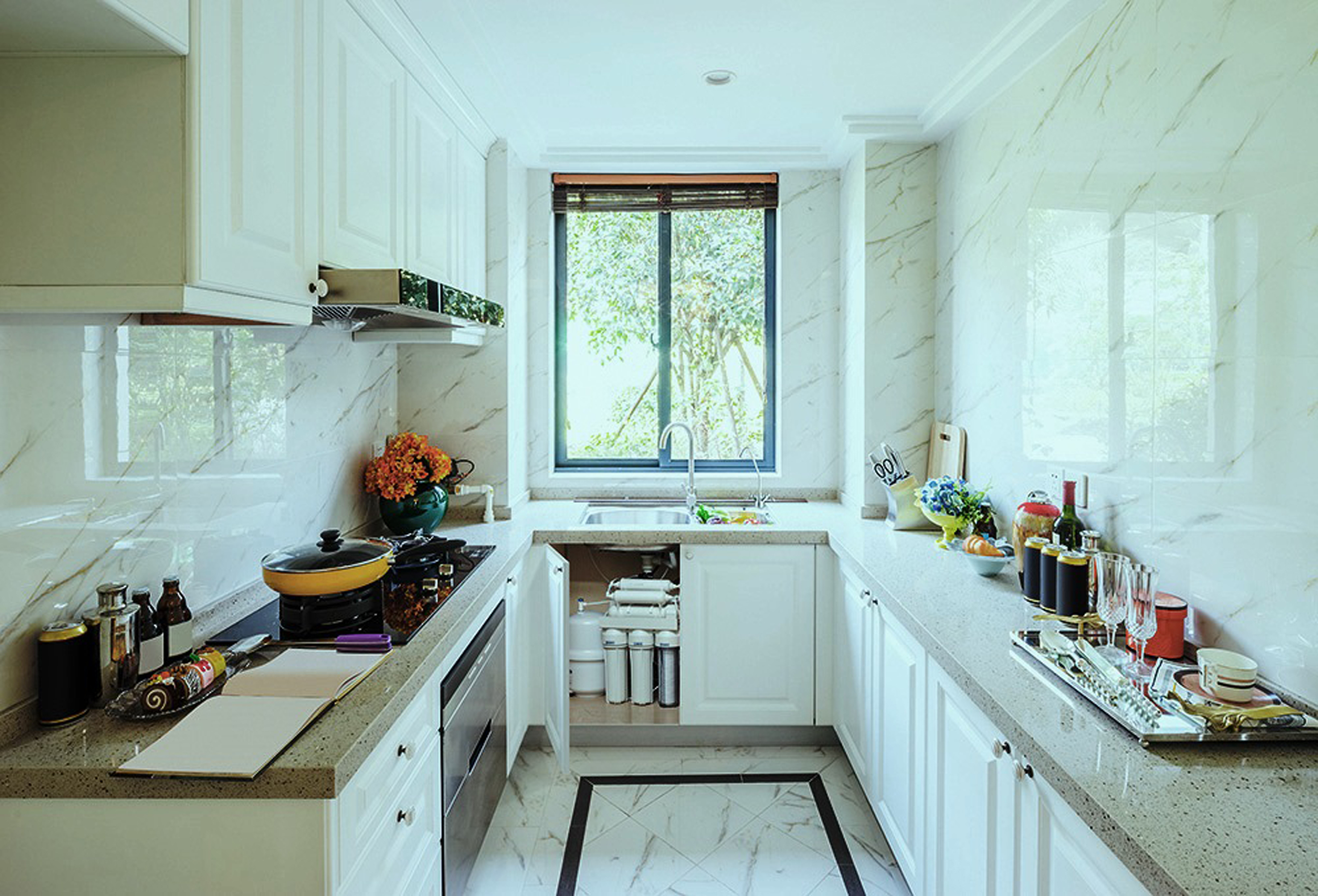Household Device RO5 – the Perfect Solution for Drinking Water
Basis RO 5 is a filter system with RO (REVERSE OSMOSIS). It is installed on the inlet of cold water inside the kitchen element and treats the water through 5 stages of filtration. It represents an unstoppable barrier to all possible pollutants that can be found in water and primarily for rock, chlorine, heavy metals, organic compounds, clouds, bacteria and viruses. By proper application, the membrane will remove all the microorganisms from tap water. Working pressure is min. 2.45 bars, and is designed for the city water supply.
DESCRIPTION OF THE FILTER WORK
The principle of work is based on reversible or reverse osmosis, which is considered to be one of the greatest technological achievements of the 20th century. The device has 5 stages of filtration, and regardless of the inlet water quality, the user has clean and healthy water at all times.
1st Stage – Stops particles bigger than 5 microns;
2nd Stage – Stops chlorine and all chlorine compounds;
3rd Stage – Stops particles bigger than 1 micron;
4th Stage – Reverse Osmosis;
5th Stage – “In line” final filter – which improves the taste of water Osmosis is a natural process that takes place in each cell allowed by a semi-permeable membrane. Only clean water is able to pass through the semi-permeable membrane. From the less concentrated solution it moves to a higher concentration solution until balance is established. In reversible or reverse osmosis, the water passage through the semi-permeable membrane takes place in the opposite direction, i.e., from a larger concentration solution to a lower concentration solution. In order for this process to be possible, high pressure action is required in order to obtain pure water. Due to this fact, you can get pure, potable water from almost any kind of water. The size of pores on the membrane is 0.0001 micron thanks to which no contaminants can pass through them since they are considerably bigger than the pore membranes. The purification process is therefore completely natural, and it’s dictated only by the large particle and its ability to pass through the membrane, or by directing too large particles into the drainage sewer. No chemical agents are added to the water when being filtrated.
Osmosis is a natural process that takes place in each cell allowed by a semi-permeable membrane. Only clean water is able to pass through the semi-permeable membrane. From the less concentrated solution it moves to a higher concentration solution until balance is established. In reversible or reverse osmosis, the water passage through the semi-permeable membrane takes place in the opposite direction, i.e., from a larger concentration solution to a lower concentration solution. In order for this process to be possible, high pressure action is required in order to obtain pure water. Due to this fact, you can get pure, potable water from almost any kind of water. The size of pores on the membrane is 0.0001 micron thanks to which no contaminants can pass through them since they are considerably bigger than the pore membranes. The purification process is therefore completely natural, and it’s dictated only by the large particle and its ability to pass through the membrane, or by directing too large particles into the drainage sewer. No chemical agents are added to the water when being filtrated.
What is reverse osmosis and what is it used for?
Reverse osmosis, also known as hyperfiltration, is the most perfect filtration process of all. This process allows the removal of the smallest particles from the water. Reverse osmosis is used for purifying water and removing inorganic minerals, salts and other impurities in order to improve appearance, taste and other water features. So, we get the highest quality water that meets the most demanding snandards that exist.
What are the beginnings of the reverse osmosis?
In 1962, the United States Government established the first reverse osmosis plant that produces 1,000 gallons of pure water per day. Today, there are over 3,000 large reverse osmosis plants, each of which produces more than a million gallons of potable water each day. In 1991, the United States Army bought 8,000 large water purifying membranes for its mobile troops in the Desert Storm. In 1993, the US Government purchased another 6,300 large membranes for the purification of water in the Midwestern Territory in the United States.
Question: What is a Reverse Osmosis System for Households?
The RO system is a household water system that uses the principle of reverse osmosis to remove 95-99% of mineral and chemical contaminants from tap water. These products provide you with quality water, with practical application installed on the tap on your sink.
What’s the Difference between Reverse Osmosis from an ordinary water filter?
In order to separate particles of impurities and sediments from the water, ordinary water filters use nets. Reverse osmosis uses a semi-permeable membrane that removes not only particles but a very high percentage of dissolved contaminants from tap water, a molecule per molecule.
What is a membrane and how does it work?
The membrane is consisted of several thin layers or thin strips that are pressed together and coiled in a spiral around the configuration of a plastic tube (also known as a composite thin coating or TFC membrane). The membrane material is semi-permeable, and it allows the water molecules to pass through it while acting as a barrier to the solute (eg. Mineral Chemical Smudges). When water passes through the membrane, molecules penetrate into the membrane, performing its function around the coil by collecting water particles in the center of the tube. The remaining contaminants are concentrated and rinced from the surface of the membrane into the drain.
Can you clarify Osmosis?
Suppose the membrane is semi-permeable and permits the passage of water through it while it does not permit passage to dissolved salts. Place the membrane between the two compartments in the container. Then place the salt solution in one half of the container and clean the water in the second half. Now the fundamental scientific principle comes to the fore. Thus, two liquids with different concentrations will try to reach equilibrium in the same system (i.e. the same concentration of contaminants) on both sides of the membrane. The only way for this is that clean water pass through the membrane to the side where salt water is found in an attempt to balance. This process is called osmosis.
What is the Real RO Process of the Household System?
The tap water first passes through a 5 micron filter (1) to remove impurities, rust and other sediments. The water then passes through the carbon block FILTER [2] which removes up to 98% of chlorine and organic chemicals. The next stage of the process is FILTER [3], a 1 micron sediment filter, or carbon block filter for filtration of multiple chemical compounds and solutions. [4] Reverse Osmosis Membrane (TFC), which separates 95-99% of dissolved solids from the water molecule. Contaminants are then removed through the drain. The next phase of the RO SYSTEM process is a small carbon filter [5] that removes remaining traces of chemicals, flavors and odors. The water produced in the reverse osmosis process is deposited in a container of 3.2 gallons [6]. Within the container there is a rubber diaphragm in the shapee of a baloon with an air pressure of 0.55 to 0.69 bar. As the tank fills up, the air pressure increases and pushes the water out when the tap is open. The last element of the system series is a chromed tap [7]. It is installed on a kitchen counter or sink. This is a double action valve that serves to break down the flow (fill the glass, hold the handle down) or continuous flow of water (fill up the coffee pot, raise the handle up).
Will Reverse Osmosis Remove Sodium from Water?
YES! Reverse osmosis was originally designed to process seawater in the US Navy. It is ideal for all those who are on a low-sodium diet.
Does Reverse Osmosis Remove Cryptosporidium Bacteria?
YES! Reverse osmosis membrane has significantly smaller pores than the size of the bacteria and viruses, the parasites or the cryptosporodium parasites. By proper application, the membrane will remove all microorganisms from tap water and produce sterile clean water.
What Is the Taste of Drinking Water Obtained by This Process?
The taste of water depends on the number of contaminants from the tap. If 95% of dissolved minerals and chemicals are removed, Reverse Osmosis water may have the taste of distilled water (no minerals), bottled water (low mineral percentage) or natural spring water (moderate mineral content).
How Will the Water from This Device Affect Mixed Drinks?
Since Reverse Osmosis removes invisible smudges that break the aroma, this allows the natural taste of your drink to come to fruition. You will be able to use less coffee and at the same time have a full flavor. Concentrated drinks such as orange juice will have a spicy, peculiar taste. You will probably also consume more water, as many people drink with soda, instant juices, concentrated juices, beer, and as an alternative to bad tap water. It also eliminates most of the calcium produced on the coffee machine’s jug so that it does not need to be cleaned frequently. You will no longer find a white skim on the inside of the pot to use for boiling water.
Aren’t the Minerals That Are Removed from Water Important to People?
Most of the minerals we need are taken from the food we eat. Only a very small percentage comes from the water we drink.
Where Is the System for Drinking Water Installed?
The system is usually installed below the sink.
Can the Adepto Company System Connect to An Additional Tap?
A T-valve 1/4 inch and pipes are required to allow the water to bring the refrigerator or additional tap water not more than 3 meters.
What Factors Influence the Quantity and Quality of Water Produced?
There are four main variables that should be considered:
1. PRESSURE. The higher the water pressure, the better the quality and the amount of produced water are. The 4.14 bar water pressure is ideal. Where there is not enough current pressure this device may contain a pump that can provide good water pressure.
2. TEMPERATURE. 24.5 * C is the ideal water temperature for Reverse Osmosis. Water with a 5 * C temperature will halve the production of RO water by half compared to the water temperature of 24.5 *C. The maximum recommended water temperature is 29.5 ° C.
3. TOTAL DISSOLVED SOLIDS (TDS). The higher the amount of mineral dissolved in water, the smaller the amount of produced water is. High levels of TOTAL DISSOLVED SOLIDS can be overcome with increased water pressure.
4. The membranes. Different membranes have different characteristics. Some products are better than others, some have better properties when removing the dirt, some are more resistant to chemical action resulting in longer lifespan. Adepto Company systems contain a TW30-1812-80 Thin Film Composite (TFC-thin composite opaque) membrane that has the best of these characteristics and is considered to be one of the best membranes in the world.
How Much Water Does the Adepto Company System Produce?
In ideal conditions, it is estimated that the TW30-1812-80 TFC membrane produces 300 liters of water per day (80 gpd at 5.5 ~ 6.8 bar). In average conditions, consumers can expect 100-150 liters of produced water per day. But that is still plenty of water for the average household that is used for drinking and cooking.
Can the Amount Of Produced Water Increase?
There are several ways:
1. During the night, fill the bowl with water from the tank. The quicker you empty the tank, the faster is production of water. By morning the tank will be filled with fresh water.
2. Another membrane can be added. An additional membrane is needed to double the capacity of the Adepto Company system.
What is the Guarantee for the Adepto Company System?
The Adepto Company system (without filters) has a one-year warranty on material and fabrication. All defective parts will be replaced free of charge within the first year. The membrane has an estimated one-year warranty.
What Is the Schedule for Maintaining the Adepto Company System?
Three pre-filter cartridges should be changed every 6 months. The first is a 5-micron sediment cartridge. The second is a carbon cartridge. The third filter is a 1-micron sediment filter. (some systems contain a carbon filter too). If you do not change the cartridge every 6 months, it is possible that chlorine will destroy the membrane.
When Should the Membrane Be Changed?
One of the indicators is a gradual reduction in water production caused by the degradation of minerals and salts on the surface of the membrane. The second is the gradual deterioration of the quality of water that is produced. You may notice a different taste or white film in a pot or while boiling water. This could mean that the reverse osmosis membrane requires replacement.
What Contaminants Does the Reverse Osmosis Remove?
The Adepto Company system contains a high-quality carbon filter that will remove more than 98% of organic chemicals from water. This includes THMs (chloroform), DBCP, lindane, TCEs (trichlorethylene), PCEs (tetrachloroethylene), carbon tetrachloride chlorine, and apart from these organic chemicals, below is a partial list of other pollutants that removes Re 1812-80 TFC membrane.
| Element | % Removed | Element | % Removed |
| Barium | 97% | Potassium | 92% |
| Bicarbonate | 94% | Radium | 97% |
| Cadmium | 97% | Selenium | 97% |
| Calcium | 97% | Silicate | 96% |
| Chromate | 92% | Silver | 85% |
| Copper | 97% | Sodium | 92% |
| Detergents | 97% | Strontium | 97% |
| Fluoride | 90% | Sulfate | 97% |
| Lead | 97% | PCBs | 97% |
| Magnesium | 97% | Insecticides | 97% |
| Nickel | 97% | Herbicides | 97% |
| Total Dissol Solids | 95% | ||
NOTE: Besides reverse osmosis treatment in addition to the standard elements that an appliance must possess, we can incorporate specially calibrated mineralizers whose aim is to provide the medically ideal balance of minerals necessary for the normal functioning of the organism.
If you have any questions regarding our reverse osmosis systems, feel free to contact us.


 BiH
BiH


